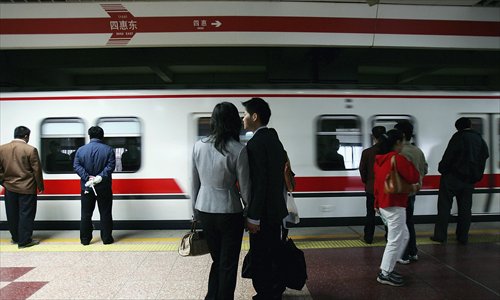HOME >> CHINA
Subway suicide
By The Beijing News Source:Global Times Published: 2016-4-4 19:18:01
After tragic incident, station staff receive training, counseling

Passengers wait for a train in Beijing's Line 1 Sihui East station. The number of daily subway passengers in Beijing has reached 12 million, according to Beijing Subway. Photo: CFP
A passenger reportedly jumped onto the tracks just as a train was coming into Wanshoulu subway station on March 2 and was killed, just the latest suicide on Beijing's subways, which has triggered discussion on what can be done to prevent such tragic incidents.There were around 39 incidents of passengers falling or jumping onto the rails in Beijing's subway system from January 2014 to March 2016.
These incidents may inspire more suicidal people to use subway trains to kill themselves, and these deaths may bring psychological harm to subway workers and passengers.
Intervention system
A subway employee working in Line 2's Qianmen station told media that the station has established an intervention system in response to people attempting to commit suicide.
The intervention system includes spotting would-be jumpers in advance, persuading them not to do it, implementing immediate rescue procedures when someone jumps onto the tracks and offering psychological counseling to traumatised staff.
Four people work to keep order on the platform of Line 1's Fuxingmen station, where several people have jumped or fallen onto the tracks. Two of them stand on raised platforms to keep an eye on passengers.
Staff remind passengers to move away from the platform edge if they spot them crossing the yellow line which shows where it is safe to stand.
Subway stations also have their staff divert foot traffic during rush hours to ensure that the crowds remain safe and people do not get accidentally shoved onto the tracks. Cameras have been placed at the entrance to the tunnels to monitor any suspicious passegner behavior in real time.
Subway stations have also started to hold training sessions for their staff on how to deal with suicides.
Qianmen station in March invited psychological experts from Beijing Huilongguan Hospital to give training to staff members, including how to effectively intervene in suicides, why people commit suicide and how to deal with the psychological damage brought to police officers and employees working in the station.
Li Xianyun, a psychiatrist from the Beijing-based Huilongguan Hospital, said that staff in subway stations have acquired the ability to recognize suicidal passengers.
"Station staff approach passengers who wander around for a long time in the station and look desperate or depressed," said Li.
Li also said that subway staff should not be panic, use sharp words or make empty promises when trying to comfort suicidal passengers.
Some staff confirmed that visions of suicides they have witnessed always appear in their minds, and that some of the drivers of trains that hit people may blame themselves for the deaths.
Li suggested that staff should seek psychological help if they cannot get over what they have seen.
Shield doors
Of the 39 incidents in the past two years, 21 occured on Line 1 and 11 on Line 2, Beijing's oldest lines. These two lines are the only ones that do not have shield doors between their platforms and the tracks. Most of the incidents happened during peak hours.
According to an official announcement and public report, 26 passengers jumped onto the rails on purpose and four people fell from the subway platforms by accident.
A 30-year-old passenger reportedly fell onto the tracks when she felt dizzy due to high blood pressure in June 2015. She was hurt but was rescued.
Chen Yanyan, a deputy dean of the Metropolitan Transportation college of the Beijing University of Technology, said that the heavy foot traffic on Line 1 and Line 2 adds the possibility of passengers being accidentally shoved onto the tracks.
Chen said that the limited space and crowded environment may make passengers feel stressed and amplify their desire to commit suicide.
Pei Zhikang from a Shanghai-based public utility research institute released an article on subway shield doors, saying that in addition to keeping passengers safe they save staff from having to rescue people that accidentally fall onto the tracks.
There are 23 stations on Line 1 and 18 stations on Line 2 without shield doors.
Many Line 1 and Line 2 stations are over 20 years old and are not designed to accommodate shield doors, in part due to the weight of such doors.
The platforms of these stations need to be rebuilt before shield doors can be installed.
An insider who declined to be identified confirmed that work to install shield doors on the two lines is ongoing and has sped up since June 2015.
The work is reportedly planned to be finished June 2016.
The Beijing News
Posted in: Society